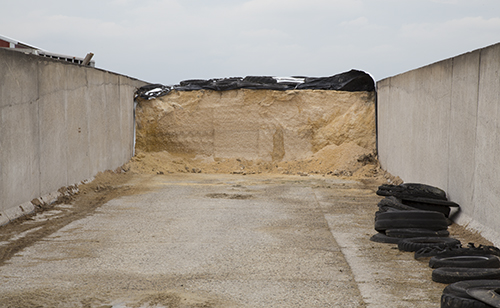
Bunker, or horizontal, silos are a great feed storage option for many farms. These structures typically have lower initial costs and lower maintenance needs than some other forms of feed storage. They also allow for high storage capacity and rapid filling.
They are not fool proof, however, and tremendous amounts of valuable feed can be wasted if not managed right. Donna Amaral-Phillips and Alexis Thompson from University of Kentucky Cooperative Extension offered some advice for utilizing bunker silos.
Harvest
Proper bunker management starts with harvesting silages at the right moisture. If feed is too dry, inadequate packing may be an issue and improper fermentation can occur. If it's too wet, seepage may escape from the bunker. Seepage contains high concentrations of soluble nutrients that can be a ground water contamination threat.
To minimize seepage, harvest corn silage when moisture content reaches between 30 to 38 percent (70 to 62 percent dry matter). As another safeguard against potential contamination, bunkers should be built at least 150 feet downstream of wells in regular soil, and 300 feet away in porous soils.
Filling and packing
Bunkers also need to be packed well. Feed should first be spread thinly on the pile and then packed. The goal is to reach 16 pounds of dry matter per cubic foot. Weights can be added to packing vehicles if additional mass is needed.
For proper packing, use this equation to determine the weight of the vehicle needed to pack the feed in relation to filling rate:
Optimum packing vehicle weight (lbs) = fill rate (tons per hour) x 8
Cover
Spoiled or rotten feed is a waste of time and money and has negative effects when fed to animals. One way to minimize waste from a bunker silo is to cover it with plastic and tires. This layer of plastic prevents oxygen from entering the pack and lessens feed spoilage.
Tires are often placed on top of the plastic layer to keep it from lifting. Half tires are preferred because they do not trap water, which could attract pests.
Feed out
Minimizing that oxygen exposure carries into the feed out phase, as oxygen creates heating and spoilage. To do this, a bunk face should always be cut strait. A silo facer can be used to do this, but if not available, one can use a tractor or skid loader bucket to push down on the face. To limit spoilage, at least 8 inches should be taken from the face every day.

The author is an associate editor and covers animal health, dairy housing and equipment, and nutrient management. She grew up on a dairy farm near Plymouth, Wis., and previously served as a University of Wisconsin agricultural extension agent. She received a master's degree from North Carolina State University and a bachelor's from University of Wisconsin-Madison.








